|

RFC
Aircraft
www.airwar1.org.uk
E-mail:
editor@airwar1.org.uk
The
early aircraft, 1914-15
The
Fokker Scourge 1915-16
1916-17
the development of fighters and bombers
1918
the final developments
An
American engined Vickers Gunbus in 1915
____________________________
The
early aircraft, 1914-15
The
first RFC aircraft deployed to France were a mixture of BE2’s
(No 2 & 4 Sqns), Bleriot monoplanes & Farmans (No 3 Sqn) and
Farmans, Avro 504s & BE8s (No 5 Sqn).
|
The
BE2 was the principal aircraft type (shown opposite).
The BE2 was not a practical military design with the pilot at the
rear having the best view and the observer sitting forward with his
view obstructed by the wing. When guns were fitted to the BE2 they
could be placed in four positions but this involved the observer
lifting the gun out of one socket and placing it in another. This
required the observer to stand and work while the aircraft was likely
to be manoeuvering. Later aircraft designs changed crew positions to
give the observer/gunner an improved field of fire.
The BE2 flew initially in a reconaissance and observation role with a
camera fitted to its side next to the pilot. During 1915 it was used
in a limited bombing role with the observer being substituted for bombs. |

Royal
Aircraft Factory BE2c |
The
BE2 was a slow and steady platform which performed reasonably until
the German fighter threat emerged in the form of the forward firing
Fokker Eindecker (monoplane) in the Summer of 1915.
The
need to defend reconnaissance aircraft was recognised in 1915 and as
well as flying escort formations, squadrons were assigned a small
number of Bristol Scouts to act as escorts. The Bristol was
ahead of its time (closer to the products of 1917) in performance but
lacked the ability to fire a gun through the propellor arc and as a
single seater, had limited capability with improvised armament.
The
French built Morane Parasol was introduced in No.3 Squadron
at the beginning of 1915 replacing the Bleriots. With a single high
wing, it offered both pilot and observer a good view of the ground.
It did however have a bad reputation as a difficult aircraft to fly.
The Morane was used in the same role as the BE2 but also as an escort
fighter. The Vickers Gunbus FB5 came into service around this
time providing a platform with a forward firing gun but it was a
relatively slow aircraft.
The
Fokker Scourge 1915-16
In
the autumn of 1915 the Germans achieved a degree of air superiority
with the Fokker Eindecker. Designed by the Dutchman, Anthony Fokker,
the aircraft was similar to a French Morane monoplane and was
equipped with an interrupter mechanism that allowed a machine gun to
be fired directly ahead through the propellor arc. It was on these
aircraft that the first of the German Aces, Böelcke and
Immelmann made their names. The ability to fire straight ahead
improved the accuracy of shooting in the air if the target could be
approached directly from behind. The tactics of employing these early
fighters developed slowly and defensive measures were possible. The
Fokker did however develop a mystique of invincibility which was only
countered by the capture of a complete aircraft in April 1916 (now in
the London Science Museum). Once the captured Fokker was flown
against Allied aircraft in tests, it became clear that it was not
particularly manoeuverable.
|
By
this time new aircraft such as the two seat FE2 and the
single seat DH2, similar in design to the Vickers Gunbus
(opposite), had begun to appear, evening the combat odds. These types
were generally known by the Germans as "Vickers", and were
both pushers allowing a machine gun to be mounted forward with a good
arc of fire. The Germans treated them with particular respect and
they proved difficult to shoot down. The single seat Martinsyde G100
was deployed in March 1916 but proved too heavy and unmanoeuvrable as
a fighter and was reassigned in July to bombing duties. French built
Nieuport fighters were also introduced. |
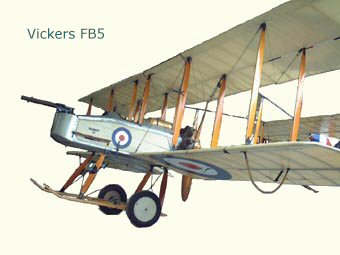 |
1916-17
the development of fighters and bombers
The
German introduction of the Albatross DIII fighter by the end of 1916
regained superiority against the Allies until the arrival of the
first of the new British fighter designs in mid 1917: the Sopwith Camel,
SE5a and Bristol F2. German tactics at the time failed
to take advantage of their superiority.
|
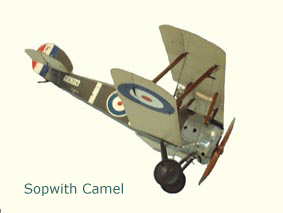
The
Royal Aircraft Factory SE5a proved to be the most successful
of the British single seat fighters. Armed with a fixed Vickers gun
and a tiltable Lewis gun above the wing.
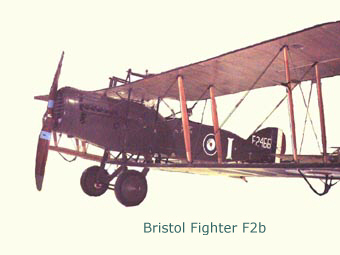 |
The
Sopwith Camel single seat fighter was used as a low level
fighter with a ground attack role, armed with small bombs and
undertaking trench strafing. The Camel had to fly directly at
its target to fire its twin Vickers guns and was consequently
vulnerable in low level work to defending machine gun fire from the
ground. Its key attribute as a fighter was excellent manoeuvrability
which made up in great measure for lack of speed.
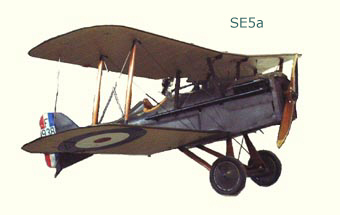
The
two seater Bristol Fighter was similarly armed but with the
addition of an observers lewis gun - sometimes a double gun mounting.
After an early setback in 1917, tactics for the Bristol Fighters were
changed from a defensive flight to full fighter tactics, manoeuvering
to get behind targets. The Bristol was also used successfully in
ground strafing alongside the Camels. Later known as the
"Brisfit", it proved to be a successful all-round fighter
and was one of the types adopted for post war service in the RAF. |
|
The
development of the true fighting scout aircraft led to the parallel
development of specialist bombers. The two seater DH4
was introduced in this role alongside Sopwith 1 1/2 Strutters and was
later largely replaced in RAF service by the DH9 (intended as
an improved DH4 it proved a disappointment). FE2's were also
used as night bombers. Camels were used in a close support bombing
role as were SE5s occasionally.
RE8's
(nicknamed Harry Tates) progressively took over the reconnaissance
and artillery spotting work of the ageing BE2's, supported by
smaller numbers of Armstrong Whitworth FKs (nicknamed Big Acks). |
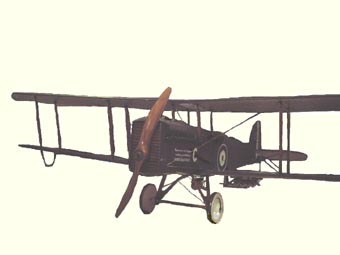
De
Haviland DH9A |
1918
the final developments
The
Sopwith Dolphin fighter was introduced to service in January
1918 and potentially offered improved performance over the Camel and
greater manoeuvrability than the SE5. Its introduction was slowed by
a shortage of engines and by the end of the war it only equipped four
squadrons. The Germans however maintained a technical edge with the
new Fokker DVII fighter though it was not delivered in sufficient
numbers to counter the allied air effort. The then giant Handley Page
bombers joined the front line in 1917 with the RNAS and later in
greater numbers with the RAF and the Independent Force in 1918 , and
were used on long range night raids into Germany.
Return
to top
Copyright
© 2004 www.airwar1.org.uk
|